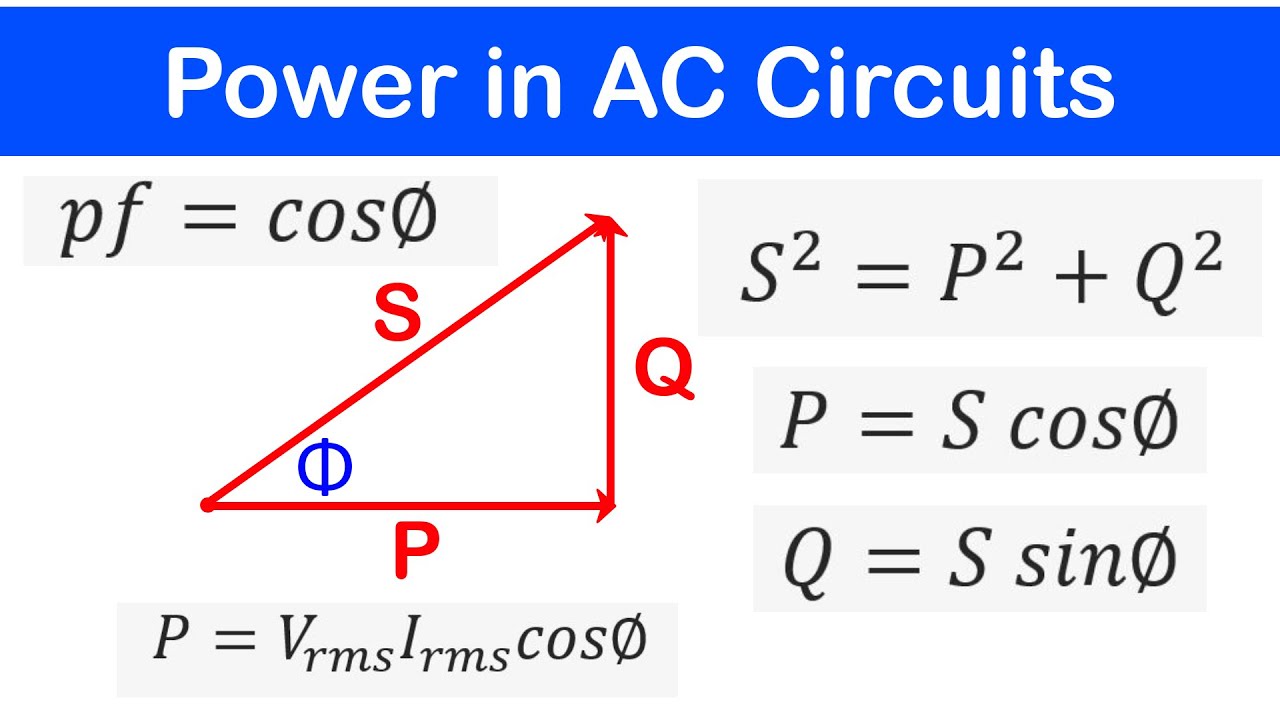What is Apparent Power ? || Example & Practice11.9 || Example & Practice 11.10 || ENA 11.5(English)
Summary
TLDRThis video provides a comprehensive overview of apparent power in electrical circuits, detailing the four types of loads: resistive, inductive, capacitive, and combined. It explains key concepts like real power, reactive power, and their relationship to apparent power through the power triangle. The lecture includes formulas for calculating these powers and introduces the power factor, highlighting its significance in energy efficiency. Various examples illustrate the application of these concepts in practical scenarios, making complex ideas accessible for learners in electrical engineering.
Takeaways
- 😀 The four types of electrical loads are resistive, inductive, capacitive, and combinational, each with distinct characteristics.
- ⚡ Resistive loads include incandescent lightbulbs and heaters, consuming real power without reactive components.
- 🔄 Inductive loads, such as motors and transformers, produce reactive power, resulting in power flow that alternates between the source and the load.
- 💡 Capacitive loads, like capacitor banks and TV picture tubes, also generate reactive power, but the current leads the voltage.
- 📉 Reactive power is measured in volt-amperes reactive (VAR), while real power is measured in watts (W), and apparent power is in volt-amperes (VA).
- 📊 The power triangle illustrates the relationship between real power, reactive power, and apparent power.
- 🔺 The apparent power (S) is calculated using the formula S = P + jQ, where P is real power and Q is reactive power.
- 🔍 The power factor, represented as cos(theta), is a crucial parameter that indicates the efficiency of power usage in an electrical system.
- 📏 The impedance angle can be derived from the voltage and current phasors, affecting the power factor calculations.
- 🧮 When dealing with AC circuits, converting peak values to RMS values is essential for accurate power calculations.
Q & A
What are the four types of electrical loads mentioned in the video?
-The four types of electrical loads are resistive loads, inductive loads, capacitive loads, and combination loads.
How is real power (active power) defined in electrical circuits?
-Real power is the average power consumed by resistive elements in a circuit, calculated as P = V_RMS I_RMS cos(θ), and is measured in watts (W).
What is reactive power and what units does it use?
-Reactive power is the power resulting from inductive or capacitive loads, and its unit is volt-amperes reactive (VAR). It is calculated using Q = V_RMS I_RMS sin(θ).
Can you explain apparent power and its units?
-Apparent power is the combination of real power and reactive power, represented as S = P + jQ, with a magnitude calculated as |S| = V_RMS I_RMS. Its unit is volt-amperes (VA).
What is the power triangle and what does it represent?
-The power triangle visually represents the relationship between real power (P), reactive power (Q), and apparent power (S). Real power is on the horizontal axis, reactive power on the vertical axis, and the hypotenuse represents apparent power.
How do you calculate the power factor in an electrical circuit?
-The power factor is calculated as the ratio of real power to apparent power, expressed as Power Factor = cos(θ) = P/S, indicating the efficiency of power usage.
What happens in a purely inductive circuit in terms of power flow?
-In a purely inductive circuit, the net power is zero; power flows positive during half cycles when the voltage source supplies energy to the inductor and flows negative when the inductor supplies energy back to the voltage source.
What is the significance of the impedance angle in power calculations?
-The impedance angle indicates the phase difference between voltage and current. It can be used to calculate both the power factor and the characteristics of the load (whether inductive or capacitive).
How can you differentiate between inductive and capacitive loads based on the power factor?
-If the power factor is lagging (current lags voltage), the load is inductive. If the power factor is leading (current leads voltage), the load is capacitive.
What are some practical examples of calculating apparent power in circuits?
-Examples include calculating apparent power using the formula S = V_RMS I_RMS for a given voltage and current, as well as using complex power calculations in circuits with resistive, inductive, and capacitive components.
Outlines

このセクションは有料ユーザー限定です。 アクセスするには、アップグレードをお願いします。
今すぐアップグレードMindmap

このセクションは有料ユーザー限定です。 アクセスするには、アップグレードをお願いします。
今すぐアップグレードKeywords

このセクションは有料ユーザー限定です。 アクセスするには、アップグレードをお願いします。
今すぐアップグレードHighlights

このセクションは有料ユーザー限定です。 アクセスするには、アップグレードをお願いします。
今すぐアップグレードTranscripts

このセクションは有料ユーザー限定です。 アクセスするには、アップグレードをお願いします。
今すぐアップグレード関連動画をさらに表示

44 - Power in AC Circuits 1 | Power Triangle - Apparent, Real and Reactive Power

Basic Electrical Engineering | Module 2 | Analysis of Single Phase AC | Part 1 (Lecture 12)

Rangkaian Resistif, Induktif, dan Kapasitif | Rangkaian AC | Part 1 | Fisika Dasar

AC Through Series RLC Circuit - AC Circuits - Basic Electrical Engineering

Complex Power || Apparent Power || Real || Example 11.11 || Practice Problem 11.11 || ENA 11.6(E)

What are Resistance Reactance Impedance
5.0 / 5 (0 votes)
